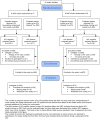The study of HIV and antenatal care integration in pregnancy in Kenya: design, methods, and baseline results of a cluster-randomized controlled trial
- PMID: 22970177
- PMCID: PMC3435393
- DOI: 10.1371/journal.pone.0044181
The study of HIV and antenatal care integration in pregnancy in Kenya: design, methods, and baseline results of a cluster-randomized controlled trial
Abstract
Background: Despite strong evidence for the effectiveness of anti-retroviral therapy for improving the health of women living with HIV and for the prevention of mother-to-child transmission (PMTCT), HIV persists as a major maternal and child health problem in sub-Saharan Africa. In most settings antenatal care (ANC) services and HIV treatment services are offered in separate clinics. Integrating these services may result in better uptake of services, reduction of the time to treatment initiation, better adherence, and reduction of stigma.
Methodology/principal findings: A prospective cluster randomized controlled trial design was used to evaluate the effects of integrating HIV treatment into ANC clinics at government health facilities in rural Kenya. Twelve facilities were randomized to provide either fully integrated services (ANC, PMTCT, and HIV treatment services all delivered in the ANC clinic) or non-integrated services (ANC clinics provided ANC and basic PMTCT services and referred clients to a separate HIV clinic for HIV treatment). During June 2009- March 2011, 1,172 HIV-positive pregnant women were enrolled in the study. The main study outcomes are rates of maternal enrollment in HIV care and treatment, infant HIV testing uptake, and HIV-free infant survival. Baseline results revealed that the intervention and control cohorts were similar with respect to socio-demographics, male partner HIV testing, sero-discordance of the couple, obstetric history, baseline CD4 count, and WHO Stage. Challenges faced while conducting this trial at low-resource rural health facilities included frequent staff turnover, stock-outs of essential supplies, transportation challenges, and changes in national guidelines.
Conclusions/significance: This is the first randomized trial of ANC and HIV service integration to be conducted in rural Africa. It is expected that the study will provide critical evidence regarding the implementation and effectiveness of this service delivery strategy, with important implications for programs striving to eliminate vertical transmission of HIV and improve maternal health.
Trial registration: ClinicalTrials.gov NCT00931216 http://clinicaltrials.gov/ct2/show/NCT00931216.
Conflict of interest statement
Figures




Similar articles
-
Implementation and Operational Research: Effects of Antenatal Care and HIV Treatment Integration on Elements of the PMTCT Cascade: Results From the SHAIP Cluster-Randomized Controlled Trial in Kenya.J Acquir Immune Defic Syndr. 2015 Aug 15;69(5):e172-81. doi: 10.1097/QAI.0000000000000678. J Acquir Immune Defic Syndr. 2015. PMID: 25967269 Free PMC article. Clinical Trial.
-
Implementation and Operational Research: Effect of Integration of HIV Care and Treatment Into Antenatal Care Clinics on Mother-to-Child HIV Transmission and Maternal Outcomes in Nyanza, Kenya: Results From the SHAIP Cluster Randomized Controlled Trial.J Acquir Immune Defic Syndr. 2015 Aug 15;69(5):e164-71. doi: 10.1097/QAI.0000000000000656. J Acquir Immune Defic Syndr. 2015. PMID: 25886930 Free PMC article. Clinical Trial.
-
The Enhanced Mentor Mother ProgrAm (EMMA) for the prevention of mother-to-child transmission of HIV in Kenya: study protocol for a cluster randomized controlled trial.Trials. 2018 Oct 30;19(1):594. doi: 10.1186/s13063-018-2975-y. Trials. 2018. PMID: 30376872 Free PMC article.
-
The impact of programs for prevention of mother-to-child transmission of HIV on health care services and systems in sub-Saharan Africa - A review.Public Health Rev. 2017 Dec 5;38:28. doi: 10.1186/s40985-017-0072-5. eCollection 2017. Public Health Rev. 2017. PMID: 29450099 Free PMC article. Review.
-
Integration of Neonatal and Child Health Interventions with Pediatric HIV Interventions in Global Health.Int J MCH AIDS. 2018;7(1):192-206. doi: 10.21106/ijma.268. Int J MCH AIDS. 2018. PMID: 30631638 Free PMC article. Review.
Cited by
-
Integrating HIV services and other health services: A systematic review and meta-analysis.PLoS Med. 2021 Nov 9;18(11):e1003836. doi: 10.1371/journal.pmed.1003836. eCollection 2021 Nov. PLoS Med. 2021. PMID: 34752477 Free PMC article.
-
Antenatal care and uptake of HIV testing among pregnant women in sub-Saharan Africa: a cross-sectional study.J Int AIDS Soc. 2016 Jan 18;19(1):20605. doi: 10.7448/IAS.19.1.20605. eCollection 2016. J Int AIDS Soc. 2016. PMID: 26787516 Free PMC article.
-
Integration of HIV care into maternal and child health services in the global IeDEA consortium.Front Glob Womens Health. 2023 Apr 17;4:1066297. doi: 10.3389/fgwh.2023.1066297. eCollection 2023. Front Glob Womens Health. 2023. PMID: 37139173 Free PMC article.
-
Determinants of non-testing for HIV among women during antenatal care follow up in sub-saharan Africa: a hierarchical analysis of recent Demographic and Health Survey datasets.BMC Health Serv Res. 2024 Dec 4;24(1):1542. doi: 10.1186/s12913-024-12035-3. BMC Health Serv Res. 2024. PMID: 39633365 Free PMC article.
-
Effectiveness of a prevention of mother-to-child HIV transmission program in Guangdong province from 2007 to 2010.BMC Public Health. 2013 Jun 18;13:591. doi: 10.1186/1471-2458-13-591. BMC Public Health. 2013. PMID: 23773623 Free PMC article.
References
-
- Mofenson LM (2010) Protecting the next generation–Eliminating perinatal HIV-1 infection. New England Journal of Medicine 362: 2316–2318. - PubMed
-
- WHO/UNAIDS/UNICEF (2009) Towards Universal Access: Scaling up HIV priority interventions in the health sector. Progress Report WHO/UNAIDS/UNICEF.
-
- McIntyre J, Lallemant M (2008) The prevention of mother-to-child transmission of HIV: are we translating scientific success into programmatic failure? Curr Opin HIV AIDS 3: 139–145. - PubMed

